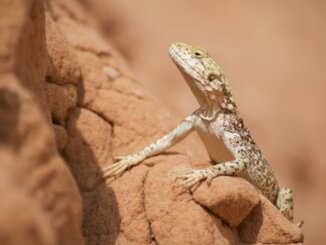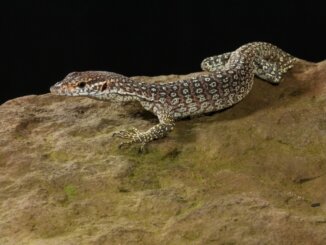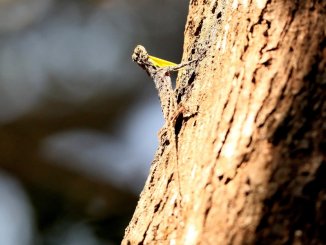The emerald tree monitor, also known as the green tree monitor, is a small-to-medium-sized monitor lizard.
This beautiful lizard specimen has striking coloration in green and turquoise hues, topped by darker, transverse dorsal bands.
Found in tropical island forests and swamps, emerald tree monitors are masters of camouflage and are highly prized as pets.
Are you considering adopting one of these exotic lizards? The guide below will tell you everything you need to know about an emerald tree monitor.
Emerald Tree Monitor Overview
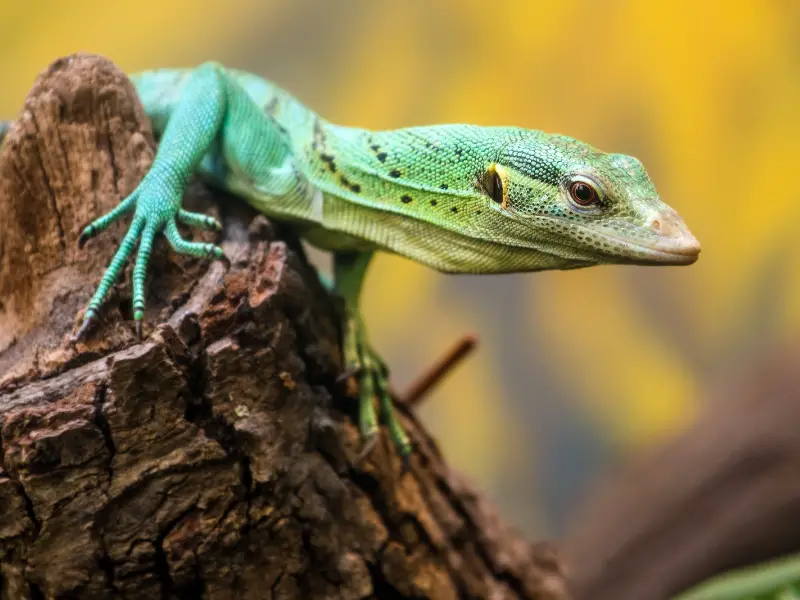
| Common name | Emerald tree monitor, green tree monitor |
| Scientific name | Varanus prasinus |
| Natural habitat | Forests, plantations, and swamps |
| Adult size | 30 to 39 inches |
| Average lifespan | 10 - 15 years |
| Diet | Carnivore - mostly insects |
| Housing | Tall vivarium (36" x 18" x 36") |
| Experience | Intermediate to advanced |
Origin
The emerald tree monitor (Varanus prasinus) is found in the forests, swamps, and plantations of Indonesia, Papua New Guinea, and the surrounding islands.
All members of this reptile species are found to the east of Lydekker’s line, in the Indo-Australian Archipelago.
(Lydekker’s Line is the name given to the easternmost reaches of oriental animals between the Oriental and Australian faunal regions).
Appearance And Behavior
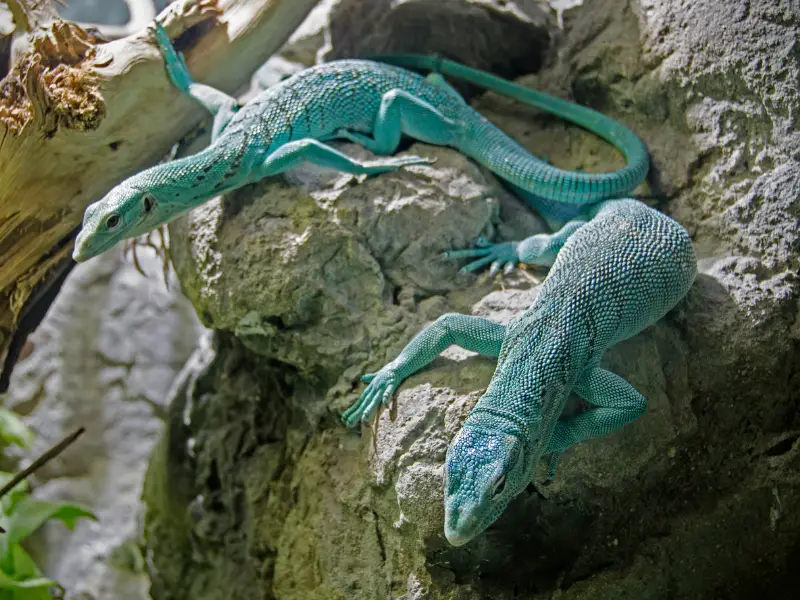
This reptile can appear as lime green, dark jade, or various blue-green shaded in between. Their bodies are covered with transverse dorsal bands, and sometimes, light blue dots.
Emerald tree monitors are arboreal, which means they live in trees in the wild.
This reptile uses its claws and tail (which is twice as long as its body) to grip branches while it climbs trees in the forest.
They have the classic monitor look with their long slim bodies and long limbs.
Like many other reptiles, they are experts in the art of camouflage. They are great escape artists in the wild as their green bodies naturally blend into the leafy environment.
And this is a good thing, as they are not naturally aggressive animals and tend to hide from danger rather than fight.
They are fast and agile creatures, and observing them in the wild has shown them to be adept swimmers, too.
Size And Lifespan
An adult emerald tree monitor will measure between 30 and 39 inches in length, with the males on the larger end of the spectrum. However, many captive specimens only grow to 24 inches in length.
In an ideal environment, an emerald tree monitor will live 10 to 15 years.
Temperament
Emerald tree monitors are the most sociable of all lizard species. They live in small groups, each one dominated by a male, and surrounded by several females. A few other males, as well as juveniles, will be in each group.
They are diurnal, which means they are most active during the day. They are also arboreal, meaning they love to climb.
As pets, they don’t mind being near you once they get used to you. However, handling is not always an option with a larger active reptile like this.
Housing An Emerald Tree Monitor3
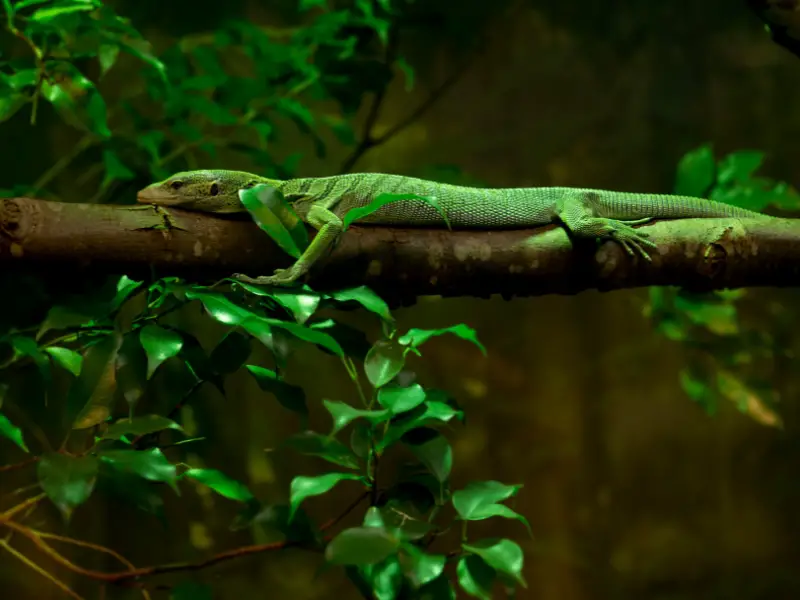
Housing an arboreal reptile that lives in forests and swamps presents a challenge to mimic that environment. The main thing to remember with this animal is that you’ll need ample space for its enclosure.
Enclosure Size
Because the typical emerald tree monitor grows to about three feet in length, you’ll need a pretty big enclosure for it.
While it is possible to buy large reptile enclosures, many owners choose to custom-build theirs. It should be at least twice the length of the reptile, but at a minimum, 36″ x 18″ x 36″.
Ideally, though, it should be around 48” x 24” x 48”.
The higher the enclosure is, the better. Tree monitors love to climb on things in the wild, and they’ll instinctually do it in captivity, too.
Include small branches and log stumps to climb on and explore.
Use materials such as wood (preferably) or plastic, but avoid glass. This reptile gets confused by it and can hurt itself running into it.
Lighting
UVB light helps reptiles, including the emerald tree monitor, produce Vitamin D through calcium absorption. So dusting their feeds with calcium powder is only one part of that equation.
Supply UVB light with a UVB lamp, and it will provide the needed warmth and light your pet needs.
Temperature And Humidity
The temperature should be 77-86° F during the day and 71-75°F at night. Create a warmer and a cooler side in the enclosure with strategically placed lights.
The easiest way to do this is to position a basking lamp above the enclosure, but to the one side, away from its hideout spots. The temperature under the basking lamp can be from 95 to 100°F.
Emerald tree monitors prefer a humidity level of 80%.
While you can spray the enclosure with a misting bottle several times throughout the day, another option is to install an automatic mister.
Invest in a hygrometer as well to check that the humidity levels are optimal.
Planting Ficus Benjamina and placing a shallow ‘pool’ in the enclosure will help to maintain humidity levels, too.
Substrate And Decoration
Choose a substrate that can absorb moisture without becoming too wet too quickly. You can use layers of soil and sand or a mix of forest soil, peat, and gravel.
Maintain an optimal moisture content with a layer of mulch or moss. Cypress mulch is a good choice.
Besides suitable substrate, aim to mimic the emerald tree monitor’s natural habitat as far as possible. Provide climbing spots, hiding places, and things to explore.
Ensure that there is enough depth to allow for burrowing and digging. Create a ‘hide box’ for them to relax in, too.
Cleaning
Change the water in the drinking bowl frequently, as these lizards can be messy. They may also use the water bowl as a toilet.
Thoroughly clean the water bowl at least once a week, more often if you notice any kind of slimy build-up.
You’re more likely to encounter pest problems if you put moss and soil that you obtained yourself into the enclosure. There may be parasites living there, so don’t do it.
Get your substrate supplies from a gardening supplies depot or a reptile store.
Wipe down enclosure walls regularly with paper towels, moistened with water. Don’t use harsh detergents to clean the enclosure.
Remove feces before they build up too much. Also, churn the substrate once a month.
The mulch bacteria will help to decompose any fecal matter that you missed when cleaning. Always provide clean water after this, as debris will have landed in it.
Emerald Tree Monitor Care
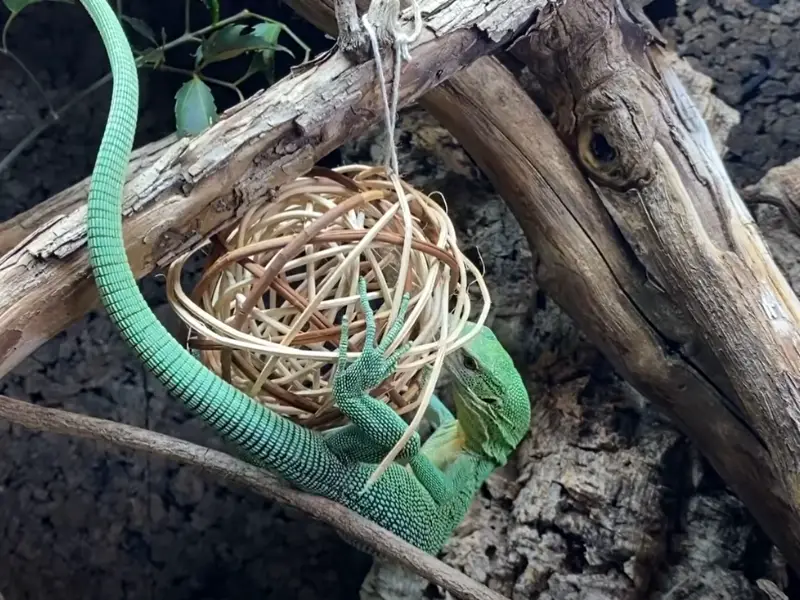
The emerald tree monitor is a pet that requires diligent care. This would be a good pet for someone with experience in reptile care, and ample space for a large enclosure.
Food And Water
Your emerald tree monitor will need plenty of fresh, clean water. As for food, they are not fussy eaters but make sure you only offer enough food for one feeding at a time.
Feed your pet a small meal of insects daily, or at least every second day.
Insects are the best choice for this reptile or the occasional pinky mouse. However, they cannot easily digest the fur of ordinary mice and rats.
Just about everything in the insect world from crickets, mealworms, or Dubia roaches to grasshoppers will do, though.
Dust the feeding insects with retile supplement calcium dust first. You can buy these at pet shops and some reptile handlers. You can even get the supplements online.
Handling
Emerald tree monitors are not suitable pets for new reptile owners with little experience. They are long-lived, need a lot of space, and require specialized care.
They are sociable and not aggressive, and make fine pets for an expert reptile handler, but do not particularly like being handled.
Their natural tendency is to flee from an unfamiliar situation. That said, if they feel threatened they will not hesitate to bite.
They can be a lot of fun to watch at play. In time, your pet may allow you to be close by. But this is not the type of lizard you pick up and handle a lot.
Common Health Issues
- Unfortunately, emerald tree monitors are often infested with parasites. Get your pet checked by a vet regularly, especially if they lose their appetite.
- Respiratory infections are another common problem. If you notice an excess of mucus, you may need to take your monitor to the vet. Keep an eye on the humidity. While too low is dangerous, too much dampness in the enclosure can worsen respiratory issues.
- Emerald tree monitors can easily become dehydrated. Keep an eye on the water supply, and always replace it with fresh water if it looks dirty. If any debris has soiled the water, change the water.
- Maintaining the correct humidity (minimum 70%, but ideally 80%) will prevent issues with shedding. However, if any shed gets stuck on the reptile’s toes or tail tip, you may need to soak the area to remove it. Don’t make a habit of soaking your monitor, though. They don’t like it.
Pairing Emerald Tree Monitors
You can keep a bonded male and female tree monitor in one enclosure, but it would have to be a very large enclosure.
It is best to keep these reptiles alone though. This is especially true of two males. They are territorial, so will fight for dominance in the enclosure.
Breeding
Not much is known about their mating habits, but they often fail to reproduce in captivity. If they do, the female will lay her eggs in the hide box in the enclosure.
In the wild, females lay a small clutch of eggs (usually 3 – 7 eggs|) in arboreal termite nests. Here, the eggs are protected from predators and kept at the right temperature for incubation.
As many as three clutches of eggs are laid in a year. The eggs have an incubation period of about 165 days.
When they hatch, the young monitors will eat termites. The young emerald tree monitors will reach sexual maturity in 2 – 3 years.
Choosing And Buying An Emerald Tree Monitor
The emerald tree monitor lizard is a vulnerable species, although not currently on the endangered list. It is a favorite amongst experienced reptile owners and handlers.
These monitors are protected under Indonesian law and kept in nature reserves in the region.
You could pay between $700 and $1200 for an emerald tree monitor. That’s quite an investment, so be sure you’re prepared to care for this reptile.
Their living conditions must be monitored carefully, as the wrong temperatures or light conditions could be fatal.
Only buy from a reputable reptile dealer, and don’t do it if you don’t have adequate reptile experience.
Emerald tree monitors are often the target of parasites. Get your new pet checked by a vet before taking it home.
The vet can do a fecal test to check for parasites, a common problem with reptiles caught in the wild.

